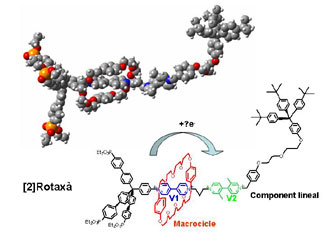"Computerized" nanomolecules

Nanotechnology – studying, designing, synthesis, manipulation and applications of materials and functional systems at nano scale (1-100 nm) – has made an amazing progress in many industries and the creation of new materials with special properties and multiple applications, mainly in Informatics and Medicine.
Most of these materials and functional systems are based on molecules, as for example the [2]rotaxanes, which present very interesting physical and chemical properties. These molecules are composed by a linear component – rod -, which is encircled by a macrocycle – wheel-, terminated by two stoppers. The rod molecule can have one or more areas called stations which can interact with the ring. This interaction can be altered by an external stimulus (as for example, oxidizing or reducing the stations, modifying the temperature or pH), and as consequence, the position of the ring can be modified. In the case of controlling the movement of the macrocycle, we are able to use these molecules in the manufacturing of the electronic devices and molecular machines (molecular transistors, logic gates, memory devices, circuits, nanovalves, molecular lifts).
In this thesis, powerful computational strategy is outlined and tested for studying a [2]rotaxane which was synthesized and experimentally characterized by the Nanochemistry group from the University College Dublin, Ireland. The reduction of this [2]rotaxane permits to tune the position of the ring (Fig. 1). As a first approach, [2]pseudorotaxanes – supramolecules composed by a linear component without stoppers which encloses a ring - that contained the same stations as in the [2]rotaxane in each reduction step were examined (Fig. 2). The behaviour of the pseudorotaxanes in two different solvents (acetonitrile and methanol) was modelled at the presence of two types of counterions, PF6- and Br-.
In this way an insight is gained into the interactions between the wheel and the stations and it was observed that these interactions diminish when reducing the stations. The results obtained related to the [2]pseudorotaxanes reproduce perfectly well the behaviour of the macrocycle in each reduction process of the [2]rotaxane found in the experimental data and it permits to apply the methodoloy used for the designing and studying of the behaviour of the new [2]rotaxanes.
References
"Molecular Modelling of Switchable [2]Rotaxanes". PhD Thesis directed by Carlos Jaime Cardiel and presented by Javier Pérez Mirón on march 14th 2008 at Facultat de Ciències i Biociències.


